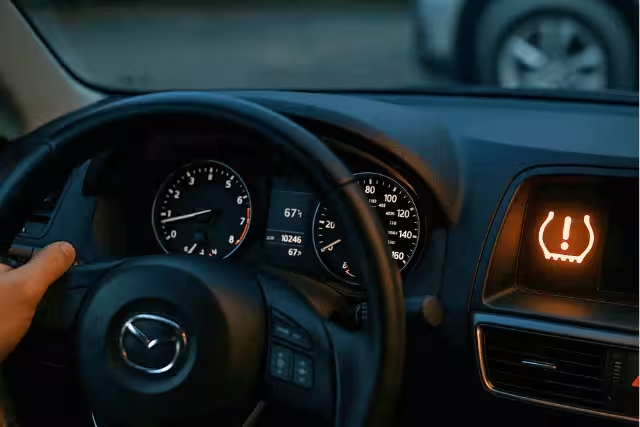If you’ve ever caught the warning light on your car’s dashboard and wondered what does TPMS mean on a car, it’s the Tire Pressure Monitoring System. This system includes sensors that check tire pressure and notify you when it drops below safe levels. Properly inflated tires increase safety, fuel efficiency, and handling, but being aware of what does TPMS means on a car is the most important thing to act quickly once the light comes on.
What is TPMS and Why is It Important?
TPMS means Tire Pressure Monitoring System. Most systems with TPMS use sensors located inside each wheel that track air pressure in real-time. If your tire drops about 25% or more below its recommended PSI, the system will issue a warning. The reason you want good tire pressure is that it reduces the chance of a blowout, improves fuel economy, and helps all tires wear evenly. Once you understand what does TPMS mean on a car, you will be able to take some action before minor tire air pressure problems can become significant safety issues.
Most modern cars use direct TPMS, which means there are small sensors mounted inside each wheel. These sensors constantly track the air pressure inside your tires and send real-time information to your car’s computer. If the system detects that your tire pressure has dropped about 25% or more below the recommended level, it triggers a warning light on your dashboard.
It might seem like just another annoying warning, but TPMS is there for a reason. Driving on underinflated tires doesn’t just affect the feel of your ride; it also increases the risk of a dangerous blowout, especially at highway speeds. Proper tire pressure helps your vehicle grip the road better, which is crucial for safe braking and cornering.
On top of safety, there’s also a practical side to TPMS. Keeping your tires properly inflated improves fuel efficiency, even a small drop in pressure can lower your gas mileage. Plus, it helps your tires wear more evenly, which means you won’t have to replace them as often, saving you money in the long run.
What Does TPMS Mean on a Car?
Notice what does TPMS light mean on a car screen; it means: your car’s sensors have detected an issue with tire pressure. It may say “LOW TIRE PRESSURE” or indicate TPMS. You need to inspect all tires and inflate them to the prescribed PSI. If the light remains on, you can only reset the system, change a sensor, or look for a slow leak. Not ignoring that warning is the initial step in safe driving.
What does TPMS light mean on a car?
What does TPMS light mean on a car? It’s an unmistakable indication that one or more tires aren’t inflated correctly. This lamp resembles a flat tire with an exclamation point. Direct actions are inspecting tire pressure, inflating as appropriate, and driving short distances to allow the system to reset itself. If this continues, it could be a sensor failure or a persistent leak. Drivers should take this seriously to avoid hazards such as uneven tire wear or handling problems.
Conclusion
Recognizing what does TPMS mean on a car isn’t just knowing a light icon on the dashboard – it’s a foundation for driving safer. While correctly inflated tires provide better performance, increased tire life, and solid fuel economy, when that warning light displays, take action. Don’t ignore it; check your tire pressures, reset the TPMS if needed, and stay safely behind the wheel.
Frequently Asked Questions (FAQs)
1. What does TPMS on a car mean?
It signals that your Tire Pressure Monitoring System has detected low inflation in one or more tires and requires inspection.
2. What does TPMS means on a car dashboard when it blinks?
A blinking TPMS light indicates a malfunction in the Tire Pressure Monitoring System (TPMS). It may stop blinking and remain solid once the system has checked.
3. What does check TPMS mean on a car?
This warning suggests a problem beyond low tire pressure, such as a sensor malfunction or a communication system issue.
4. What does the TPMS light on a vehicle indicate if it remains illuminated after the pressures have been repaired?
If the TPMS light persists after inflating the tires, the system needs to be reset, or a sensor needs to be recalibrated or replaced.
5. Can cold temperatures influence TPMS warnings?
Yes. Low temperatures can decrease tire pressure and trigger the TPMS warning, even with properly inflated tires.
6. What does TPMS stand for on a vehicle if it is turning on and off?
It generally indicates that your tire pressure is close to the limit. Daytime temperature fluctuations may cause the light to come on or off, depending on tire inflation.
7. What does checking TPMS on a vehicle entail when igniting?
If it only occurs when starting the car and disappears after a few seconds, it’s likely just a self-test by the system. If it’s constant, have it checked out.
TPMS light on? Don’t ignore it! Understand what your car is telling you and drive safer. Learn how to check your tire pressure and keep your vehicle running smoothly today. For any query, connect with AutoMagToday.

